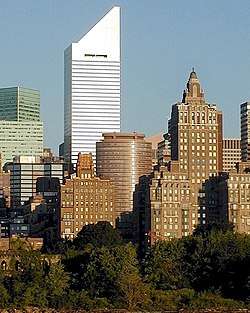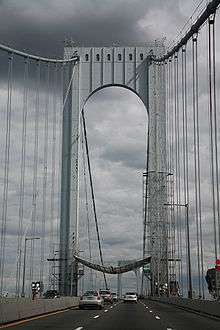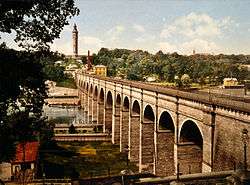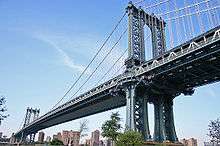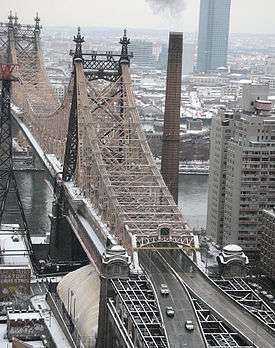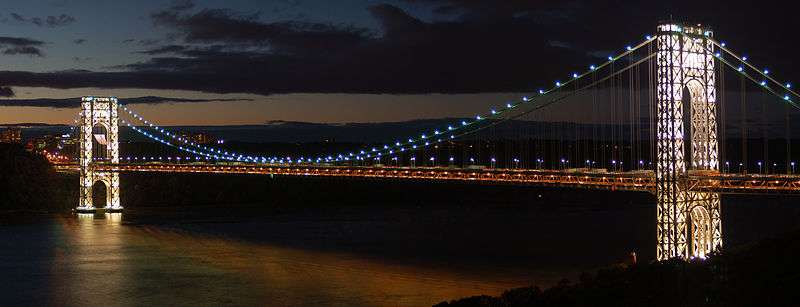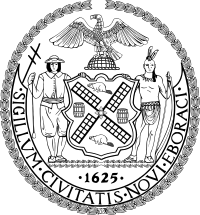Architecture of New York City
The building form most closely associated with New York City is the skyscraper, which has shifted many commercial and residential districts from low-rise to high-rise. Surrounded mostly by water, the city has amassed one of the largest and most varied collection of skyscrapers in the world.[1]
New York has architecturally significant buildings in a wide range of styles spanning distinct historical and cultural periods. These include the Woolworth Building (1913), an early Gothic revival skyscraper with large-scale gothic architectural detail. The 1916 Zoning Resolution required setback in new buildings, and restricted towers to a percentage of the lot size, to allow sunlight to reach the streets below.[2] The Art Deco design of the Chrysler Building (1930) and Empire State Building (1931), with their tapered tops and steel spires, reflected the zoning requirements. The Chrysler building is considered by many historians and architects to be one of New York's finest, with its distinctive ornamentation such as V-shaped lighting inserts capped by a steel spire at the tower's crown.[3] An early influential example of the international style in the United States is the Seagram Building (1958), distinctive for its facade using visible bronze-toned I-beams to evoke the building's structure. The Condé Nast Building (2000) is an important example of green design in American skyscrapers.[4]
The character of New York's large residential districts is often defined by the elegant brownstone rowhouses, townhouses, and tenements that were built during a period of rapid expansion from 1870 to 1930.[5] In contrast, New York City also has neighborhoods that are less densely populated and feature free-standing dwellings. In the outer boroughs, large single-family homes are common in various architectural styles such as Tudor Revival and Victorian.[6][7][8] Split two-family homes are also widely available across the outer boroughs, for example in the Flushing area.
Stone and brick became the city's building materials of choice after the construction of wood-frame houses was limited in the aftermath of the Great Fire of 1835.[9][10] Unlike Paris, which for centuries was built from its own limestone bedrock, New York has always drawn its building stone from a far-flung network of quarries and its stone buildings have a variety of textures and hues.[11] A distinctive feature of many of the city's buildings is the presence of wooden roof-mounted water towers. In the 19th century, the city required their installation on buildings higher than six stories to prevent the need for excessively high water pressures at lower elevations, which could burst municipal water pipes.[12] Garden apartments became popular during the 1920s in outlying areas, including Jackson Heights in Queens, which became more accessible with expansion of the subway.[13]
Concentrations of buildings

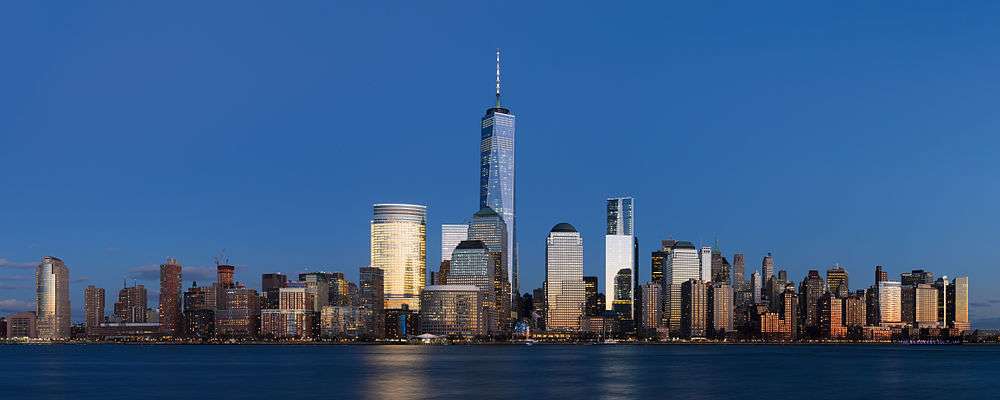
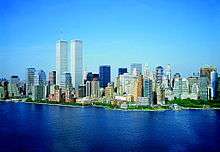
New York has two main concentrations of high-rise buildings: Midtown Manhattan and Lower Manhattan, each with its own uniquely recognizable skyline. Midtown Manhattan, the largest central business district in the world, is home to such notable buildings as the Empire State Building, the Chrysler Building, Citigroup Center and Rockefeller Center. Lower Manhattan comprises the third largest central business district in the United States (after Midtown and Chicago's Loop). Lower Manhattan was characterized by the omnipresence of the Twin Towers of the World Trade Center from its completion in 1973 until its destruction in the September 11 attacks in 2001.
In the first decade of the 21st century, Lower Manhattan saw reconstruction to include the new One World Trade Center. The Downtown skyline received new designs from such architects as Santiago Calatrava and Frank Gehry. In 2010, a 749-foot (228 m), 43-story tower named 200 West Street was built for Goldman Sachs across the street from the World Trade Center site.
New York City has a long history of tall buildings. It has been home to 10 buildings that have held the world's tallest fully habitable building title at some point in history, although half have since been demolished. The first building to bring the world's tallest title to New York was the New York World Building, in 1890. Later, New York City was home to the world's tallest building for 75 continuous years, starting with the Park Row Building in 1899 and ending with 1 World Trade Center upon completion of the Sears Tower in 1974. The 1899 Park Row Building, one of the world's earliest skyscrapers, is still standing.

The high-rise buildings of Brooklyn constitute a third, much smaller skyline. Downtown Brooklyn is also experiencing an extensive building boom, with new high rise luxury residential towers, commercial space and a new arena in the planning stages. The building boom in Brooklyn has had a great deal of opposition from local civic and environmental groups which contend that Brooklyn needs to maintain its human scale. The borough of Queens has also been developing its own skyline in recent years with One Court Square (formerly the Citigroup Building, currently the tallest building in NYC outside Manhattan), and the Queens West development of several residential towers along the East River waterfront.
The 1916 Zoning Resolution required setback in new buildings, and restricted towers to a percentage of the lot size, to allow sunlight to reach the streets below.[2]
Famous buildings
Early 20th century
Beaux-Arts
Grand Central Terminal is located in East Midtown close to the Chrysler Building. The railroad terminal, completed in 1913, is the third on its site.[14] It was built in the Beaux-Arts style by the firms Reed and Stem and Warren and Wetmore.[15] It became a National Historic Landmark in 1976.[16]
Art Deco
The Empire State Building, a 102-story contemporary Art Deco style building in Midtown Manhattan, was designed by Shreve, Lamb and Harmon and finished in 1931. It was the world's tallest building for 42 years. The tower takes its name from the nickname of New York State.[17]:413[18]:46 It was the first building to go beyond the 100-story mark, and has one of the world's most visited observation decks, which sees about 4 million visitors a year.[19] The building was built in just 14 months.[20]
Completed in 1930, the Chrysler Building is a distinctive symbol of New York, standing 1,046 feet (319 m) high in East Midtown, Manhattan.[18]:14 Originally built for the Chrysler Corporation,[21] the building is presently co-owned by Aby Rosen's RFR Holding LLC, in a joint venture with the Austrian SIGNA Group.[22][23] The Chrysler Building was the first structure in the world to surpass the 1,000 foot threshold.[24]
30 Rockefeller Plaza is a slim Art Deco skyscraper and the focal point of Rockefeller Center. It stands 850 ft (259 m) with 70 floors. Built in 1933[25] and originally called the RCA Building, it was later called the Comcast Building.[26] The frieze above the main entrance was executed by Lee Lawrie and depicts Wisdom, along with a phrase from scripture that reads "Wisdom and Knowledge shall be the stability of thy times", originally found in the Book of Isaiah, 33:6.[27]
International Style
The International Style was a groundbreaking exhibition at the Museum of Modern Art that completely changed the face of architecture in New York and the world. Mies Van Der Rohe, a focus of the show, later built the Seagram Building on Park Ave at 53rd Street. One of the most important buildings for modern architecture, the Seagram Building transformed its midtown site, the development of tall buildings, and the history of architecture. Other architects replicated details from Seagram within New York and around the world for decades following its completion in the late 1950s. The bronze extrusions attached to the mullions are exemplary of this trend in tall building design and can be seen in many cities.
Late 20th century
The MetLife Building, formerly the Pan Am Building, was the largest commercial office building in the world when it opened on March 7, 1963.[28] It stands directly north of Grand Central Terminal.[29]
The World Trade Center's twin towers were the city's tallest buildings from 1973 until their destruction in the September 11 attacks. The towers rose 1,368 feet (417 m) and 1,362 feet (415 m) respectively, both 110 floors. The North Tower's 360 foot antenna housed most of the city's communications, while the South Tower was home to a popular observation deck. They were the tallest buildings in the world until Chicago's 1,454-foot Sears Tower was completed in 1974.[30]
Citigroup Center is a 59-story office tower located at 53rd Street and Lexington Avenue in Midtown Manhattan. It is considered one of the most important post-war skyscrapers to be in erected in New York City. The striking design of the steeply slanted roof, the sleek aluminum-clad facade, and its base on four stilts over a church also on the site made the skyscraper an instant architectural icon. The sloping roof houses the building's mechanical and ventilation systems. The designers settled on an aluminum-clad facade to reduce the weight load on the building's foundation and support structures, since its entire weight would be supported by stilts.[31] To prevent swaying, a "tuned mass damper" was later added on the roof.[32]
21st century
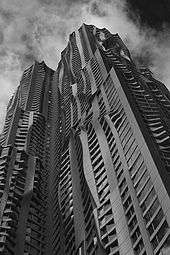
Time Warner Center is a mixed-use skyscraper at Columbus Circle on Manhattan's Upper West Side. It was the first major building to be completed since the September 11 attacks.[33]
The Condé Nast Building, officially Four Times Square, is a modern skyscraper in Times Square in Midtown Manhattan and one of the most important examples of green design in skyscrapers in the United States. Environmentally friendly gas-fired absorption chillers, along with a high-performing insulating and shading curtain wall, ensure that the building does not need to be heated or cooled for the majority of the year. Office furniture is made with biodegradable and non-toxic materials. The air-delivery system provides 50% more fresh air than is required by New York City Building Code, and a number of recycling chutes serve the entire building. Being the first project of its size to undertake these features in construction, the building has received an award from the American Institute of Architects, as well as AIA New York State.
Hearst Tower, located in Midtown Manhattan at 300 West 57th Street, is another example of the new breed of green design skyscrapers in New York City. Hearst Tower is a glass and steel construction skyscraper which rests on the base of the original 1920s Hearst Corporation Building. Hearst Tower is easily identified by the dramatic interlocking triangular glass panels designed by British architect Lord Norman Foster. Hearst Tower is also the first skyscraper in New York City to be awarded the coveted Gold LEED Certified rating by the United States Green Building Council.
Tallest buildings
The 15 tallest standard structures, which include those with the 10 highest antennae or radio towers (pinnacles)
| Std. rank |
Name | Year |
Location (Midtown & Lower Manhattan) |
Floors |
Pinnacle height ft |
Pinn. hgt m |
Standard height ft |
Std. hgt m |
Notes |
|---|---|---|---|---|---|---|---|---|---|
| 1 | One World Trade Center | 2013 | West Street & Vesey Street | 104 | 1,792 | 546 | 1,776 | 541 | |
| 2 | Empire State Building | 1931 | Fifth Avenue & West 34th Street | 102 | 1,472 | 449 | 1,250 | 380 | [34][35] |
| 2 | 432 Park Avenue | 2014 | Park Avenue & East 57th Street (Manhattan) | 89 | 1,396 | 426 | 1,396 | 426 | |
| 3 | Bank of America Tower | 2009 | Sixth Avenue between 42nd & 43rd Sts | 54 | 1,200 | 370 | 1,200 | 370 | [36][37] |
| 4 | Chrysler Building | 1930 | Lexington Avenue & 42nd Street | 77 | 1,046 | 319 | 1,046 | 319 | [38][39] |
| 5 | New York Times Building | 2007 | Eighth Avenue between 41st & 42nd Sts | 52 | 1,046 | 319 | 1,046 | 319 | [40][41] |
| 6 | One57 | 2014 | West 57th Street between 6th & 7th Aves | 75 | 1,005 | 306 | 1,005 | 306 | [42][43] |
| 7 | American International Bldg † | 1932 | Pine, Cedar and Pearl Streets | 66 | 952 | 290 | 952 | 290 | [44][45] |
| 8 | 40 Wall Street ‡ | 1930 | Wall Street between Nassau & William Sts | 70 | 927 | 283 | 927 | 283 | [46][47] |
| 9 | Citigroup Center | 1977 | 53rd Street between Lexington & 3rd Aves | 59 | 915 | 279 | 915 | 279 | [48][49] |
| 10 | Trump World Tower | 2001 | First Avenue between 47th & 48th Streets | 72 | 861 | 262 | 861 | 262 | [50][51] |
| 11 | Comcast Building (ex-RCA Building and ex-GE Building) | 1930 | 30 Rockefeller Plaza, 6th Ave, 49th & 50th Sts | 70 | 850 | 259 | 850 | 259 | [52][53] |
| 12 | CitySpire Center | 1987 | West 56th Street between 6th & 7th Aves | 75 | 814 | 248 | 814 | 248 | [54][55] |
| 13 | One Chase Manhattan Plaza | 1961 | between Pine, Liberty, Nassau & William Sts | 60 | 813 | 248 | 813 | 248 | [56][57] |
| 14 | Condé Nast Building | 2000 | Broadway between 42nd & 43rd Streets | 48 | 1,118 | 341 | 809 | 247 | [58][59] |
| 15 | MetLife Building (ex Pan Am) | 1963 | 200 Park Avenue at East 45th Street | 59 | 808 | 246 | 808 | 246 | [60][61] |
- † (constructed as the Cities Service Company Building)
- ‡ (constructed as the Bank of Manhattan Trust Corporation Building)
- All addresses are in Midtown Manhattan except those in lighter shades, which are in Lower Manhattan.
Residential architecture
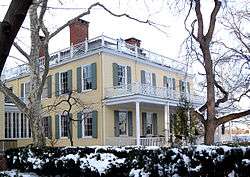 Gracie Mansion, the mayor's official residence.
Gracie Mansion, the mayor's official residence.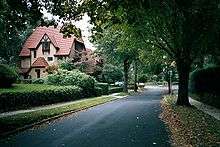 A large single family home in Forest Hills Gardens, Queens.
A large single family home in Forest Hills Gardens, Queens. A Tudor Revival style mansion in Flushing, Queens constructed in 1924.
A Tudor Revival style mansion in Flushing, Queens constructed in 1924.- A home in Tottenville, Staten Island.
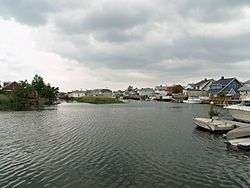 Houses placed on Hawtree Creek in Howard Beach, Queens.
Houses placed on Hawtree Creek in Howard Beach, Queens. 21st century residential towers in Long Island City, Queens.
21st century residential towers in Long Island City, Queens.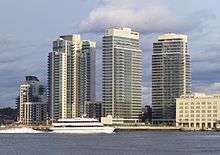 New high-rise condominiums on the Williamsburg, Brooklyn waterfront.
New high-rise condominiums on the Williamsburg, Brooklyn waterfront. Queen Anne architecture c. 1899 in Dyker Heights, Brooklyn.
Queen Anne architecture c. 1899 in Dyker Heights, Brooklyn._by_David_Shankbone.jpg) The Dakota Building on the Upper West Side of Manhattan.
The Dakota Building on the Upper West Side of Manhattan.- Tenement buildings in the Lower East Side.
 Brownstone townhouses in Harlem.
Brownstone townhouses in Harlem. Apartment buildings in Hell's Kitchen.
Apartment buildings in Hell's Kitchen.
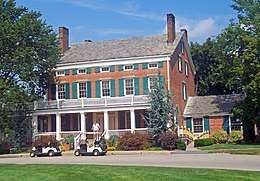
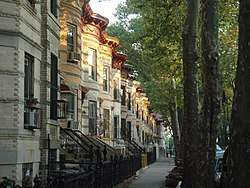
As New York City grew, it spread outward from where it originally began at the southern-tip of Manhattan Island into surrounding areas.[62] In order to house the burgeoning population, farm land and open space in Upper Manhattan, the Bronx, Queens, Brooklyn, and Staten Island were developed into neighborhoods of brownstones, apartment buildings, multi-family and single-family homes.[63] The density of this new construction generally depended on the area's proximity and accessibility to Manhattan.
The development of these areas was often spurred by the opening of bridges and the connection of boroughs via public transportation. For example, the Brooklyn Bridge was completed in 1883 and connects Brooklyn and Manhattan across the East River. Brooklyn Heights, a nabe on the Brooklyn waterfront, is often credited as the United States' first suburb.[64] The bridge allowed an easier commute between Brooklyn and Manhattan and spurred rapid construction, development, and redevelopment. The Verrazano-Narrows Bridge, completed in 1964,[65] opened up many areas of Staten Island to residential and commercial development, especially in the central and southern parts of the borough, which had previously been largely undeveloped. Staten Island's population doubled from about 221,000 in 1960 to about 443,000 in 2000.
By 1870, stone and brick had become firmly established as the building materials of choice, as the construction of wood-frame houses had been greatly limited in the aftermath of the Great Fire of 1835.[9][10] Unlike Paris, which for centuries was built from its own limestone bedrock, New York has always drawn its building stone from a network of quarries, sometimes quite distant, which is evident in the variety of textures and hues of stone seen in the city's buildings. In the days before rail, stones were floated down the Hudson River or along the Atlantic Seaboard from pits in New England. While trains brought marble from Vermont and granite from Minnesota, it was Connecticut brownstone that was so popular in the construction of New York's row homes in the late 19th century that the term brownstone became synonymous with row house.
Beginning in the 1950s, public housing projects dramatically changed the city's appearance. New, large scale (frequently high-rise) residential complexes replaced older communities, at times removing artifacts and landmarks that would now be considered of historic value. During this period, many of these new projects were built in an effort towards urban renewal championed by the famed urban planner Robert Moses. The resulting housing projects have suffered from inconsistent funding, poor maintenance, and high crime, prompting many to consider these projects a failure.
A distinctive feature of residential (and many commercial) buildings in New York City is the presence of wooden roof-mounted water towers, which were required on all buildings higher than six stories by city ordinance in the 19th century because the municipal water pipes could not withstand the extraordinarily high pressure necessary to deliver water to the top stories of high-rise buildings.[12]
Bridges and tunnels
New York City is located on one of the world's largest natural harbors.[66] The boroughs of Manhattan and Staten Island are their own islands, while Queens and Brooklyn are located at the west-end of the larger Long Island. This precipitates a need for an extensive infrastructure of bridges and tunnels. Nearly all of the city's major bridges and several of its tunnels, have broken or set records. For example, the Holland Tunnel was the world's first vehicular tunnel when it opened in 1927.[67]
The Queensboro Bridge is an important piece of cantilever architecture. The towers of the Brooklyn Bridge are built of limestone, granite, and Rosendale cement. Their architectural style is neo-Gothic, with characteristic pointed arches above the passageways through the stone towers. This bridge was also the longest suspension bridge in the world from its opening until 1903, and the first steel-wire suspension bridge. The Manhattan Bridge, Throgs Neck Bridge, Triborough Bridge, and Verrazzano-Narrows Bridge are all examples of Structural Expressionism.[68][69]
Street grid
Formulated in the Commissioners' Plan of 1811, New York adopted a visionary proposal to develop Manhattan north of 14th Street with a regular street grid. The economic logic underlying the plan, which called for twelve numbered avenues running north and south, and 155 orthogonal cross streets, was that the grid's regularity would provide an efficient means to develop new real estate property. Frederick Law Olmsted, the designer of Central Park, disapproved.
New Yorkers commonly give addresses by the street and avenue number, as in "34th & 5th" for the Empire State Building.
One of the city's most famous thoroughfares, Broadway, is one of the longest urban streets in the world. Other famous streets include Park Avenue and Fifth Avenue. 42nd Street is the capital of American theater. The Grand Concourse, modeled on the Champs-Élysées in Paris, is the most notable street in the Bronx. The City Beautiful movement inspired similar boulevards in Brooklyn, known as parkways.
See also
- List of buildings
- List of National Historic Landmarks in New York
- List of New York City Designated Landmarks
- List of tallest buildings in New York City
- List of cities with most skyscrapers
- Art Deco architecture of New York City
References
- "About New York City". Emporis. Archived from the original on March 9, 2007. Retrieved March 21, 2007.
- Fischler, Raphael (1998). "The Metropolitan Dimension of Early Zoning: Revisiting the 1916 New York City Ordinance". Journal of the American Planning Association. 64 (2).
- "Favorites! 100 Experts Pick Their top 10 New York Towers". The Skyscraper Museum. January 22, 2006. Retrieved April 11, 2007.
- Pogrebin, Robin (April 16, 2006). "7 World Trade Center and Hearst Building: New York's Test Cases for Environmentally Aware Office Towers". The New York Times. Retrieved July 19, 2006.
- Plunz, Richar A. (1990). "Chapters 3 [Rich and Poor] & 4 [Beyond the Tenement]". History of Housing in New York City: Dwelling Type and Change in the American Metropolis. Columbia University Press. ISBN 0-231-06297-4.
- Garb, Margaret (March 1, 1998). "If You're Thinking of Living In/Riverdale, the Bronx; A Community Jealous of Its Open Space". The New York Times.
- "New York Metro: 6 Affordable Neighborhoods". nymag.com.
- Shaman, Diana (February 8, 2004). "If You're Thinking of Living In/Douglaston, Queens; Timeless City Area, With a Country Feel". The New York Times.
- Lankevich (1998), pp. 82–83.
- Wilson, Rufus Rockwell (1902). New York: Old & New: Its Story, Streets, and Landmarks. J. B. Lippincott. p. 354.
- B. Diamonstein–Spielvoegel, Barbaralee (2005). The Landmarks of New York. Monacelli Press. ISBN 1-58093-154-5. See also Whyte, William H. (1939). The WPA Guide to New York City. New Press. ISBN 1-56584-321-5.
- Elliot, Debbie (December 2, 2006). "Wondering About Water Towers". National Public Radio. Archived from the original on May 3, 2007. Retrieved April 11, 2007.
- Hood, Clifton (2004). 722 Miles: The Building of the Subways and How They Transformed New York. Johns Hopkins University Press. pp. 175–177. ISBN 0-8018-5244-7.
- "Modern Terminal Supplies Patrons with Home Comforts". The New York Times. February 2, 1913. ISSN 0362-4331. Retrieved February 2, 2018.
- Schlichting, Kurt C. (2001). Grand Central Terminal: Railroads, Architecture and Engineering in New York. Baltimore: Johns Hopkins University Press. pp. 118-120. ISBN 978-0-8018-6510-7.
- ""Grand Central Station" August 11, 1976, by Carolyn Pitts" (PDF). National Register of Historic Places Inventory-Nomination. National Park Service. August 11, 1976.
- Jackson, Kenneth T., ed. (2010). The Encyclopedia of New York City (2nd ed.). New Haven: Yale University Press. ISBN 978-0-300-11465-2.
- Willis, Carol; Friedman, Donald (1998). Building the Empire State. New York: W.W. Norton. ISBN 978-0-393-73030-2.
- Bagli, Charles V. (December 24, 2011). "Empire State Building Observation Decks Generate Startling Profits". The New York Times. ISSN 0362-4331. Retrieved October 24, 2017.
- "EMPIRE STATE TOWER, TALLEST IN WORLD, IS OPENED BY HOOVER; THE HIGHEST STRUCTURE RAISED BY THE HAND OF MAN" (PDF). The New York Times. May 2, 1931. ISSN 0362-4331. Retrieved October 23, 2017.
- Pierpont, Claudia Roth (November 18, 2002). "The Silver Spire: How two men's dreams changed the skyline of New York". The New Yorker. Archived from the original on August 25, 2004. Retrieved February 14, 2016.
- Seythal, Thomas (March 15, 2019). Hummel, Tassilo (ed.). "Austria's Signa, RFR Holding buy New York's Chrysler Building". Reuters. Retrieved May 13, 2019.
- Lily Katz (March 8, 2019). "Chrysler Building to Sell to RFR for About $150 Million". Bloomberg News. Retrieved March 10, 2019.
- "FIRST BUILDING TO RISE ABOVE 1,000 FEET HIGH" (PDF). The Troy Times. Troy, New York. April 4, 1930. p. 9. Retrieved November 3, 2017 – via Fultonhistory.com.
- "Two Skyscrapers Will Open This Week; RCA and John Street Buildings Ready; TWO SKYSCRAPERS OPEN TOMORROW" (PDF). The New York Times. April 30, 1933. ISSN 0362-4331. Retrieved November 11, 2017.
- Hevesi, Dennis (July 14, 1988). "30 Rock? RCA? NBC? No, G.E.!". The New York Times. Retrieved November 14, 2017.
- Roussel, Christine (May 17, 2006). The Art of Rockefeller Center. New York: W.W. Norton & Company. p. 55. ISBN 978-0-3930-6082-9.
- Horsley, Carter C. The MetLife Building, The Midtown Book. Accessed September 30, 2007. "When it was completed, the 2,400,000 sq ft (220,000 m2) building became the world's largest office building in bulk, a title it would lose a few years later to 55 Water Street downtown."
- "PAN AM BUILDING DEDICATED IN N.Y.; 100 Million Structure, 59 Stories Tall, City's Biggest Other Speakers at Event". The New York Times. March 8, 1963. Retrieved December 24, 2018.
- McDowell, Edwin (April 11, 1997). "At Trade Center Deck, Views Are Lofty, as Are the Prices". The New York Times. ISSN 0362-4331. Retrieved November 21, 2008.
- Postal, Matthew A (December 6, 2016). "Citicorp Center" (PDF). New York City Landmarks Preservation Commission. Retrieved December 10, 2018.
- Greer, William R. (October 24, 1982). "Rx for Swaying Skyscrapers". The New York Times. Retrieved July 25, 2009.
- Inside the Time Warner Center, Newsday, Feb. 19, 2004
- "Empire State Building". Emporis.com. Retrieved November 19, 2007.
- "Empire State Building". SkyscraperPage.com. Archived from the original on November 12, 2007. Retrieved November 22, 2007.
- "Bank of America Tower". Emporis.com. Retrieved December 31, 2007.
- "Bank of America Tower". SkyscraperPage.com. Archived from the original on June 15, 2008. Retrieved June 16, 2008.
- "Chrysler Building". Emporis.com. Retrieved November 19, 2007.
- "Chrysler Building". SkyscraperPage.com. Archived from the original on November 12, 2007. Retrieved November 22, 2007.
- "New York Times Tower". Emporis.com. Retrieved November 19, 2007.
- "New York Times Headquarters". SkyscraperPage.com. Archived from the original on December 12, 2007. Retrieved November 22, 2007.
- "One57". The Skyscraper Center. CTBUH. Retrieved March 17, 2015.
- "One57". SkyscraperPage.com. Retrieved March 17, 2015.
- "American International". Emporis.com. Retrieved November 19, 2007.
- "American International Building". SkyscraperPage.com. Archived from the original on December 17, 2007. Retrieved November 22, 2007.
- "The Trump Building". Emporis.com. Retrieved November 19, 2007.
- "Trump Building". SkyscraperPage.com. Archived from the original on December 17, 2007. Retrieved November 22, 2007.
- "Citigroup Center". Emporis.com. Retrieved November 19, 2007.
- "Citigroup Center". SkyscraperPage.com. Archived from the original on December 17, 2007. Retrieved November 22, 2007.
- "Trump World Tower". Emporis.com. Retrieved November 19, 2007.
- "Trump World Tower". SkyscraperPage.com. Archived from the original on December 17, 2007. Retrieved November 22, 2007.
- "GE Building". Emporis.com. Retrieved November 19, 2007.
- "GE Building". SkyscraperPage.com. Archived from the original on December 17, 2007. Retrieved November 22, 2007.
- "CitySpire Center". Emporis.com. Retrieved November 19, 2007.
- "CitySpire Center". SkyscraperPage.com. Archived from the original on November 29, 2007. Retrieved November 22, 2007.
- "One Chase Manhattan Plaza". Emporis.com. Retrieved November 19, 2007.
- "One Chase Manhattan Plaza". SkyscraperPage.com. Archived from the original on December 17, 2007. Retrieved November 22, 2007.
- "Condé Nast Building". Emporis.com. Retrieved November 19, 2007.
- "Conde Nast Building". SkyscraperPage.com. Archived from the original on December 17, 2007. Retrieved November 22, 2007.
- "MetLife Building". Emporis.com. Retrieved November 19, 2007.
- "MetLife Building". SkyscraperPage.com. Archived from the original on December 17, 2007. Retrieved November 22, 2007.
- "The Battery: Where Manhattan Begins!". March 22, 2010.
- "upper Manhattan history - Ephemeral New York". ephemeralnewyork.wordpress.com.
- "Archived copy". Archived from the original on February 18, 2007. Retrieved February 8, 2012.CS1 maint: archived copy as title (link)
- "History - Staten Island History".
- "Watch New York Harbor Clip - How the Earth Was Made - HISTORY".
- "Holland Tunnel (I-78)". www.nycroads.com.
- "New York Architecture Images-Manhattan Bridge". nyc-architecture.com.
- "New York Architecture Images-". nyc-architecture.com.
Further reading
- White, Norval & Willensky, Elliot (2000). AIA Guide to New York City (4th ed.). New York: Three Rivers Press. ISBN 978-0-8129-3107-5.
- Federal Writers' Project (1939). The WPA Guide to New York City, The New Press (1995 reissue).
External links
| Wikimedia Commons has media related to Architecture of New York City. |
- Downtown Brooklyn Development - New York City Dept. Of Planning
- Lower Manhattan Development - Lower Manhattan Development Corp.
- The City Review - information on buildings and architecture by neighborhood
- Tom Fletcher's New York Architecture Images and Notes ...
- Avery Architectural and Fine Arts Library. "New York City Buildings". Research Guides. New York: Columbia University. Archived from the original on February 23, 2014. Retrieved February 6, 2014.
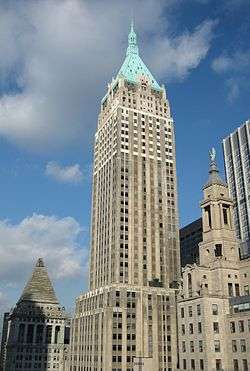

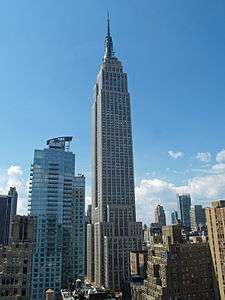
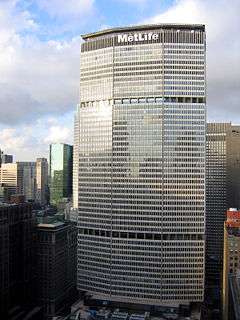
.jpg)
